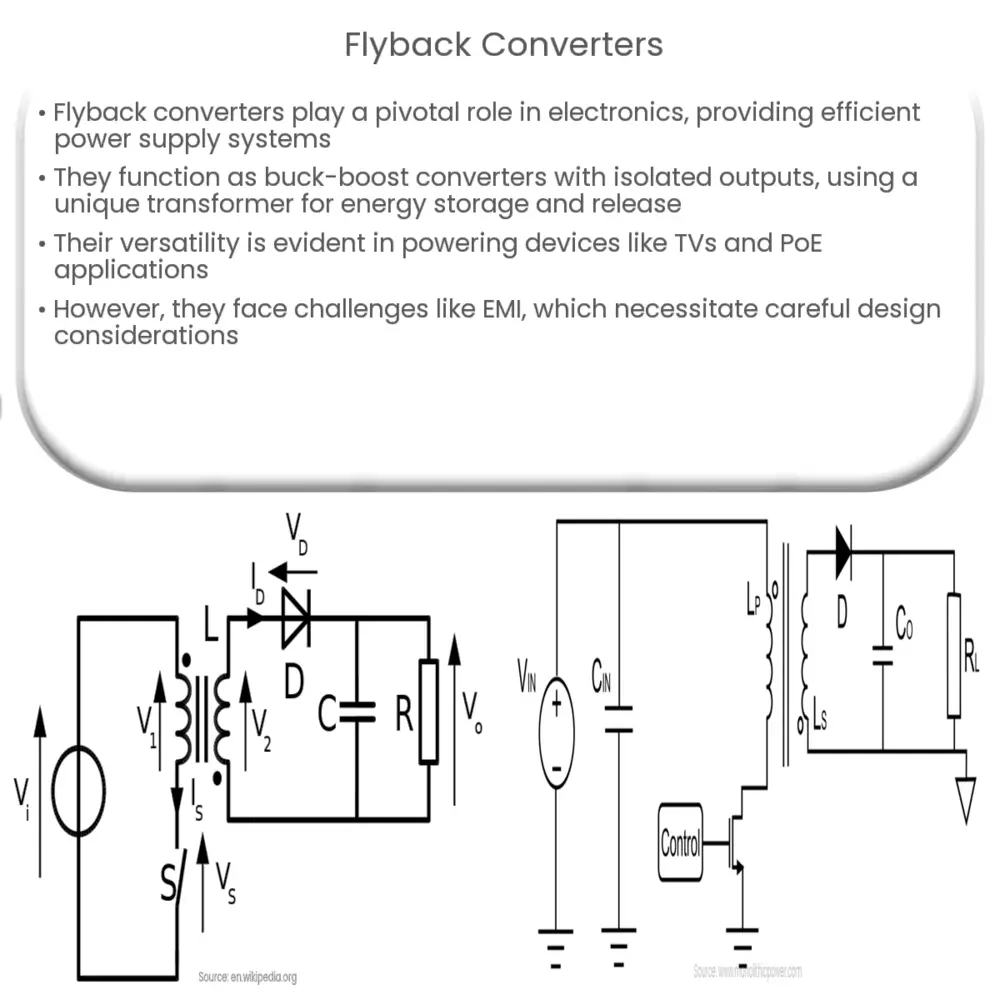Explore the fundamentals of flyback converters, their design, operation, applications, and future trends in our comprehensive guide.

Fundamentals of Flyback Converters
In the world of electronics, power supply systems are integral to the functioning of a wide array of devices, and among these systems, the Flyback Converter holds an important position. Originating from the design of the horizontal deflection circuits in cathode ray tube (CRT) televisions, flyback converters are now extensively used due to their efficiency and simplicity.
What are Flyback Converters?
Essentially, a flyback converter is a type of buck-boost converter with an isolated output. It operates in two significant states: the ‘on’ state when the switch is closed and the ‘off’ state when the switch is open. The primary characteristics of flyback converters that differentiate them from other types of converters are their transformer and their unique method of transferring energy.
Structure of Flyback Converters
At the heart of a flyback converter is its transformer, which is not used in the traditional sense. Unlike regular transformers, which transfer power continuously, the flyback transformer stores energy from the input during the ‘on’ state of the switch and then releases it to the output in the ‘off’ state. This technique of energy transfer is called ‘Flyback’ and thus gives the converter its name.
Operation of Flyback Converters
The operation of the flyback converter is divided into two stages. During the first stage (the ‘on’ state), energy from the input power source is stored in the transformer as magnetic energy. During this stage, the switch in the circuit is closed, and the diode is reverse-biased, preventing any energy from flowing to the output.
The second stage (the ‘off’ state) begins when the switch opens. The collapsing magnetic field in the transformer induces a voltage in the secondary winding, which forward-biases the diode and allows the stored energy to flow to the output. It is this clever mechanism of energy storage and release that makes the flyback converter a versatile power supply system.
Applications of Flyback Converters
Flyback converters find their applications in various domains due to their capability to provide electrical isolation, multiple outputs and the ability to step-up or step-down voltages. They are commonly used in powering devices like televisions, computer monitors, and in power over ethernet (PoE) applications.
Despite their versatility, they are not without their disadvantages. Issues such as power handling limitations and electromagnetic interference (EMI) can arise, depending on the design and application of the converter. Nonetheless, these are usually manageable with the right design techniques.
Design Considerations for Flyback Converters
Designing a flyback converter requires careful consideration of several factors. These include power handling capability, the choice of components, the operating frequency, and EMI concerns. As a rule of thumb, flyback converters are most efficient when designed for applications requiring power outputs of less than 100 Watts.
Component selection is critical. For instance, the switch must be able to withstand the high voltages generated during the ‘off’ state, and the diode should be able to handle the high current during the ‘on’ state. Similarly, the transformer needs to be designed considering the peak magnetic field strength, so it does not go into saturation.
Addressing Electromagnetic Interference
One significant disadvantage of flyback converters is the high-frequency EMI, a byproduct of their operation. This can interfere with other electronic components or devices and can be a critical issue in sensitive applications. However, this can be mitigated with the proper design and selection of components. Shielding techniques and EMI filters are common solutions to this problem.
Future Trends
With the advancements in semiconductor technology, the future of flyback converters looks promising. Developments like the incorporation of GaN (Gallium Nitride) transistors allow for operation at higher frequencies, thus reducing the size of the transformers and other components, resulting in more compact and efficient designs.
Conclusion
In conclusion, flyback converters are an important class of power supply systems with a broad range of applications. Their simple design and operation, combined with the capability to provide electrical isolation and multiple outputs, make them a versatile tool in the electronics industry. However, issues such as EMI and power handling limitations require careful consideration during the design phase. As technology progresses, it is expected that these challenges will be addressed, paving the way for more efficient and compact flyback converters in the future.

